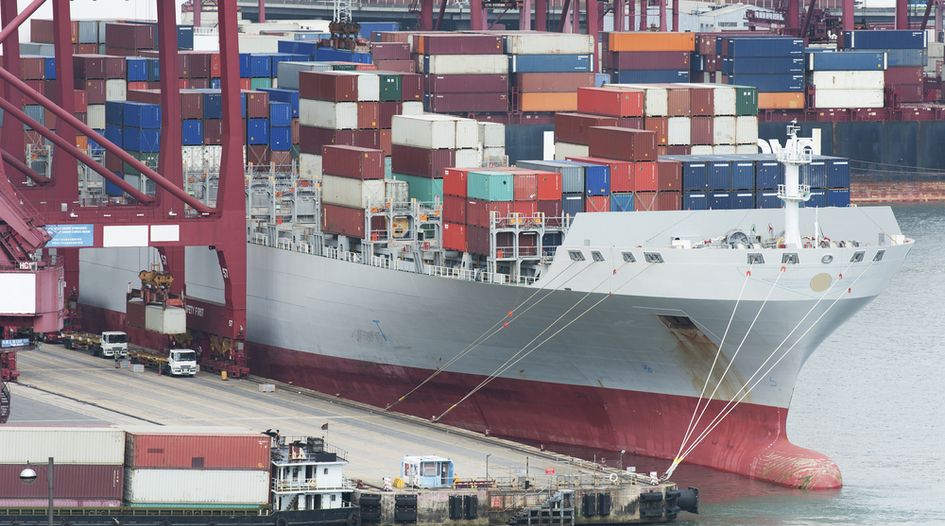Hong Kong: How customs is boosting enforcement

This is an Insight article, written by a selected partner as part of WTR's co-published content. Read more on Insight
Legal framework
Hong Kong has a common law system of jurisprudence in which certain intellectual property rights are also specifically protected under statute. The key pieces of legislation relating to IP protection include:
- Trade Marks Ordinance (Cap. 559) (TMO)
- Copyright Ordinance (Cap. 528)
- Registered Designs Ordinance (Cap. 522)
- Patents Ordinance (Cap. 514)
- Trade Descriptions Ordinance (Cap. 362) (TDO)
- Prevention of Copyright Piracy Ordinance (Cap. 544).
Unregistered rights such as unregistered trademarks are generally protected under the common law tort of passing off (similar to the concept of unfair competition). Passing off occurs when a trader misrepresents or ‘passes off’ their goods or services as being those of another.
Hong Kong is a party to various major international IP conventions and treaties, including the Nice Agreement on International Classification of Goods and Services, the Berne Convention for the Protection of Literary and Artistic Works, and the Paris Convention for Protection of Industrial Property. Its IP framework meets the standards laid out in the World Trade Organisation’s TRIPS Agreement. Legislation has been passed to pave the way for the adoption of the Madrid Protocol for International Registration of Marks, though this has not yet been implemented.
Hong Kong has a separate legal system from Mainland China and registration of IP rights in one jurisdiction does not extend protection to the other. However, there is a structured framework for the mutual enforcement of civil and commercial court judgments between the Mainland and Hong Kong. Notably, the Mainland Judgments in Civil and Commercial Matters (Reciprocal Enforcement) Ordinance (Cap. 645), which came into force on 29 January 2024, expressly covers judgments to do with specified IP rights. This new ordinance makes it easier for IP rights holders to enforce a judgment against the assets of a defendant across the border, strengthening Hong Kong’s position as an attractive venue for dispute resolution of cases with a Mainland Chinese connection. However, the ordinance excludes the recognition and enforcement of judgments relating to the validity of IP rights. This reflects the fact that IP rights are territorial in nature, and their validity is left to the jurisdiction of domestic courts.
Border measures
Hong Kong is often targeted as a strategic hub for the transshipment of counterfeit goods, owing to its geographical proximity to manufacturing bases on the mainland and its established transportation infrastructure. The Hong Kong Customs and Excise Department conducts random inspections on imports and exports at the border. Seizures primarily relate to trademark counterfeiting, copyright piracy and false trade descriptions. In 2022, Customs reported 275 cross-boundary infringement cases, involving over 500,000 counterfeit items collectively worth more than HK$160 million (approximately US$20.4 million). This represented a 3.6% decrease from the previous year. Commonly seized items include clothes, accessories, electronics and watches.
Seizure and recordal
For Customs enforcement, the IP rights holder must first complete the Customs recordal process. The holder will need to authorise a competent examiner who can distinguish counterfeit goods from genuine ones. The examiner must undertake to give evidence and be willing to give expert testimony in court. As the examiner may be required to conduct examinations at short notice, it is generally advisable to appoint a Hong Kong-based representative; in some limited circumstances, examinations may also be conducted remotely. Once the recordal application is completed, Customs will arrange an interview with the nominated examiner to assess their competence. Through the application and interview processes, the examiner appointed by the rights holder is expected to adequately explain the source and shipment route of genuine products, the range and price point of genuine products, the typical security features of genuine products, the factors differentiating the official genuine products and parallel-imported products, and the background and experience of the examiner – all supported by full documentation and product samples.
Customs actively conducts enforcement operations at the border with respect to imports, exports and transshipments. They routinely seize suspicious goods and will detain them at no cost to the IP rights holders. When suspected infringing goods have been detained, Customs may carry out their own investigation and act on intelligence. If the suspicious goods are determined by the examiner to be infringing, Customs will, upon consultation with the Department of Justice, proceed to arrest the infringers and prosecute the case through the criminal justice system. After the successful conviction of the infringer, Customs will likely destroy the infringing goods.
The Hong Kong Customs recordal process is more stringent than similar processes in some other jurisdictions, with a focus on the competence and capability of the authorised examiner. However, Customs’ authority to investigate, seize goods, make arrests and initiate criminal proceedings in relation to suspected infringing activities both across the border and within the domestic market has the advantage of effectively enforcing against and deterring future infringement. Customs is also renowned for its high efficiency, seamless communication and proactive approach.
Parallel imports
Parallel imports generally do not constitute trademark infringement under the ‘exhaustion of rights’ defence (TMO s.20(1)). This defence adopts the doctrine of ‘international exhaustion’ – the view that the rights of trademark owners or their exclusive licensees should be exhausted once their goods have been put on the market anywhere in the world with their consent (ie, parallel imports). To address safety concerns (especially with respect to parallel imported pharmaceutical and food products), TMO s.20(2) sets out a statutory exception whereby the exhaustion defence does not apply when the condition of the goods has been changed or impaired after they have been put on the market and the use of the registered trademark in relation to those goods is detrimental to the distinctive character or repute of the mark.
The application of the s.20(2) statutory exception to the exhaustion defence was recently clarified in Mary Kay Inc. v Zhejiang Tmall (2022) HKCFI 1403. In this case, the plaintiff cosmetics company commenced proceedings for trademark infringement and passing off against two third-party vendors in respect of the sale of parallel imports through e-commerce platforms. The defendants sought to rely on the exhaustion defence. In response, the plaintiff sought to invoke the s.20(2) statutory exception, claiming that since production codes had been removed from the product packaging, the condition of the goods had been changed, and therefore the exhaustion defence did not apply.
The judge held that the s.20(2) statutory exception only applies where the physical condition of the goods inside the packaging has been adversely affected. The removal of production lot codes from the outer packaging was not enough to change or impair the condition of the goods. Therefore, the defendants were able to rely on the exhaustion defence.
Criminal prosecution
Customs is the designated government department for criminal prosecutions in respect of trademark counterfeiting, copyright piracy and unfair trade practices. Criminal cases are brought before the Magistrates Courts in the area where the offence is committed. Criminal sanctions in respect of trademark counterfeiting are found in the TDO, while the Copyright Ordinance (Cap. 528) and Prevention of Copyright Piracy Ordinance (Cap. 544) set out provisions for criminal proceedings in respect of copyright infringement. Customs officers and the police have extensive powers to conduct searches and investigations under the Organised and Serious Crimes Ordinance (Cap. 455).
Trademark counterfeiting
Counterfeiting is addressed under the TDO, under which it is a criminal offence to apply to any goods (a) any trademark, or (b) any mark so nearly resembling a trademark as to be calculated to deceive; without the trademark owner’s consent (TDO s.9(1)(b)) (ie, a forged trademark). It is also a criminal offence to sell or possess for sale any goods to which a forged trademark is applied (TDO s. 9(2)). The defendant has the burden of proving that it did have the owner’s consent to use the trademark in question.
In this provision, the term ‘trademark’ is widely defined so that not only trademarks that are registered in Hong Kong are protected. It is sufficient if the trademark is capable of registration in Hong Kong and already registered or applied for in a Paris Convention country or World Trade Organisation member country (provided that, in the case of an applied-for mark, it has been less than six months since the application date in that country). Having said that, in practice, Customs generally requires the trademark to be registered in Hong Kong as a pre-requisite for recordal and/or commencement of criminal enforcement actions.
A common defence to the offence of selling or possessing for sale goods to which a forged trademark is applied (under TDO s.9(2)) is the defendant’s proof that they did not know, or had no reason to suspect and could not with reasonable diligence have ascertained, that a forged trademark had been applied to the goods (TDO s.26AAB).
The maximum penalty for conviction of a trademark counterfeiting offence is a fine of HK$500,000 (approximately US$64,000) and imprisonment for five years. The infringing goods may be forfeited, and the court may order the destruction and disposal of the goods.
Copyright piracy
It is a criminal offence to sell, import, export or make for sale an infringing copy of a copyright work without a licence. Cases prosecuted under these provisions have commonly involved pirated music recordings and films. The defendant has the burden to prove that they had reasonable grounds to be satisfied that the copy was not an infringing copy and that there were no circumstances that would have led him reasonably to suspect that the copy was infringing. The time limit for criminal prosecution under the Copyright Ordinance is three years from the date of the offence.
The maximum penalty for conviction of most copyright offences is a fine of HK$50,000 (approximately US$6,400) in respect of each infringing copy and imprisonment for four years. For an offence relating to an article designed for making infringing copies, the penalty is a fine of HK$500,000 (approximately US$64,000) and eight years’ imprisonment.
Unfair trade practices
The Trade Descriptions Ordinance makes it a criminal offence to engage in five specific types of unfair trade practices:
- making misleading omissions (ie, hiding material information);
- aggressive commercial practices (eg, harassment or coercion);
- bait advertising;
- bait and switch; and
- wrongly accepting payment (eg, taking payment without the intention of supplying a product).
The maximum penalty upon conviction is a fine of HK$500,000 (approximately US$64,000) and imprisonment for five years. If the accused is cooperative, Customs may accept a written undertaking in return for no criminal prosecution.
Civil enforcement
Cease and desist approach
A common first step in the civil enforcement process is to issue a cease and desist letter to the infringer, demanding that they immediately stop the infringing activities, undertake to destroy or deliver up infringing materials, declare the details of the infringing activity (including any income gained, and the details of manufacturers, suppliers, distributors and customers), pay damages and costs, and refrain from infringing in the future. The letter will alert the infringer to the fact that the rights holder is on their case, so it is crucial that any investigations, test purchases and other evidence preservation exercises are duly completed beforehand.
Civil litigation
If the infringer does not respond to the cease and desist letter, or if their infringing activities continue, then the rights holder may consider initiating a civil action. It is important to first consider the merits of the case, cost efficiency and the overall objectives of litigating. Although there is no IP court in Hong Kong, IP cases that are brought before the High Court are put on a specific IP list and heard by specialist IP judges. Proceedings are issued by filing a Writ and a Statement of Claim detailing the facts, causes of action and relief sought. The plaintiff must serve the Writ on the defendant, after which the defendant will have 14 days to file an Acknowledgement of Service. Where the Writ is indorsed with a Statement of Claim, the defendant must serve a defence within 28 days from the time of giving notice of their intention to defend.
IP cases at first instance generally take 18 to 30 months to reach trial from the issue of the Statement of Claim. Remedies typically sought by a plaintiff may include an injunction, disclosure of information, delivery up or destruction of the infringing products, damages, or an account of profits and legal costs. In the recent case Warner Bros v D.K.A.J Limited (HCIP 67/2019), Warner Bros successfully obtained an injunction against the operators of an unauthorised Harry Potter-themed café, restraining them from using Warner Bros’ trademarks and copyright materials. The court also granted an account of profits in the plaintiff’s favour and issued a declaration of invalidity in respect of the café operators’ associated Hong Kong-registered trademark ‘9 3/4 café’.
The courts have the power to grant interim relief to parties in the proceedings. The most common type of interim relief sought by plaintiffs in IP cases is an interlocutory injunction, although this will only be granted when the plaintiff can successfully prove that (i) there is a risk of irreparable damage if the injunction is not granted, and monetary compensation given at trial would not be an adequate remedy; (ii) there is a serious question to be tried (ie, a good arguable case raised by the plaintiff); and (iii) the balance of convenience tips in favour of the plaintiff.
In Pandora A/S & ors v Glamulet & ors (HCA 2941/2015) the jewellery retailer Pandora obtained an ex parte interlocutory injunction prohibiting an infringing e-commerce retailer from subscribing to the plaintiff’s ‘PANDORA’ trademark through Google AdWords and similar services. Google AdWords is a pay-per-click system that allows businesses to pay to get their advertisements ranked at the top of the search results page for chosen keywords. This was the first Hong Kong decision prohibiting the unauthorised use of a trademark as a search word in Google AdWords.
When an interlocutory injunction is granted, the court will almost always require the applicant to give a cross-undertaking in damages. This is intended to compensate the defendant if it is later found that the interim injunction should not have been granted. An interlocutory injunction has proved to be the most effective remedy for IP rights holders to stop infringement within the territory of Hong Kong (though it is not enforceable in Mainland China). In practice, it also helps bring the defendant to the negotiating table, because a defendant would generally not breach the injunction in order to avoid the risk of contempt of court, which is criminal in nature. An interlocutory injunction may become permanent if the plaintiff is successful at trial.
Other types of interim relief include a Norwich Pharmacal Order (ie, third-party disclosure order), under which the court can compel a third party to disclose information relating to the wrongdoing (eg, contact information of infringers, transaction and shipment details, etc.); and an interim freezing order (ie, a Mareva injunction) to restrain a party from dissipating its assets before final judgment is entered. A Mareva injunction is considered a draconian remedy and the applicant must satisfy various requirements, including showing that there is a real risk that the counterparty will dispose of its assets unless restrained by the court.
Damages in copyright infringement cases
An update to the Copyright Ordinance that came into effect in May 2023 introduced two new statutory factors for the court to consider when awarding additional damages in civil copyright infringement cases. The original factors include the benefit gained by the infringer and the flagrancy of the infringement. The new factors are (i) unreasonable conduct of an infringer after having been informed of the infringement (eg, attempts made to expedite sales of the infringing products or destroy evidence of the infringement); and (ii) the likelihood of widespread circulation of infringing copies as a result of the infringement (eg, through online communications).
Anti-counterfeiting online
Counterfeiters commonly exploit third-party e-commerce sites (such as Taobao, JD.com, Tmall and Alibaba) and social media platforms (like WeChat, Instagram and Facebook) to sell their infringing products. Their methods have become increasingly sophisticated in recent years. Some use images of genuine products to market counterfeit goods. Other sellers mask their counterfeiting activities by mixing and selling both genuine and counterfeit products simultaneously. While most online platforms offer a complaint mechanism through which brand owners can submit takedown requests, counterfeiters have become increasingly adept at evading justice. To counter takedown requests, some counterfeiters use digital methods to fabricate trademark certificates or authorisation letters from brand owners. There is also the challenge of locating and identifying the actual perpetrators. Even after an infringing site or page has been successfully taken down, perpetrators often swiftly set up shop elsewhere.
Customs has responded to this trend by setting up a dedicated ‘Anti-Internet-Piracy Team’ comprising over 40 investigators who conduct online investigations and take enforcement action in respect of online IP infringement. In 2022, the team handled 80 online counterfeiting cases, resulting in the seizure of counterfeit and pirated goods worth over HK$5 million (approximately US$640,000). This represented a 22% decrease from the previous year. The cases related primarily to the sale of counterfeit goods on online marketplaces.
Some brand owners have risen to the challenge by joining forces with other brand owners, as well as with operators of online platforms such as Alibaba and Google. A coordinated, collaborative enforcement effort can have significantly more impact than a single takedown request. It is therefore always advisable for affected brand owners to maintain a dialogue with the operators of e-commerce platforms on which they are aware of infringement.
In the Mary Kay case discussed above, the court held that the online platforms involved in the sale of parallel imports were not liable for infringement. The plaintiff claimed that the operators of the e-commerce sites Tmall and Taobao had committed passing off, asserting that the online stores in question had been set up to mislead the public into believing that the vendors were associated with their brand. However, the judge held that the e-commerce platforms were not liable, as mere knowledge and intent were not sufficient to make them infringers or joint tortfeasors. Applying principles from the UK case L’Oreal v eBay [2009] RPC 21, the judge decided that the provision of an online platform to facilitate the marketing and sale of products by vendors is not sufficient as authorisation or procurement of infringement. In addition, there was no evidence that the e-commerce platforms had approved or procured the vendors to sell the products. Notably, the judge held that even if the platform operators had financially benefited from product sales, this would not have been sufficient to make them liable.
The Court of Appeal’s approach in Mary Kay contrasts with the approach of the Court of First Instance in Karibu Baby Limited v Global Yield International Limited (HCA 1765/2014), in which the operator of an online marketplace was found liable for patent infringement and secondary copyright infringement as a result of its sale of a foldable bathtub that was identical to the plaintiff’s patented invention, even though the defendant was only a middleman who connected buyers with sellers. In that case, the defendant tried to assert that it had conducted searches to satisfy itself that the products being sold were not infringing. However, the court held that the searches must have given the defendant at least constructive, if not actual knowledge of the infringement at the time it marketed the products.
Customs tackles copyright infringement online, including concerning pirated movies, videos, games and songs. Its efforts are bolstered by an Electronic Crime Investigation Centre that employs data analytics to analyse information retrieved from various Internet platforms. Internet piracy commonly takes the form of streaming as opposed to downloading. However, no copying is involved in the streaming process, and streaming was therefore not caught under our old copyright regime. In response, the Copyright Ordinance was amended in 2023 to introduce a technology-neutral exclusive right for copyright owners to communicate their works to the public through any mode of electronic transmission. Copyright owners now have civil recourse to infringing acts, regardless of the mode of electronic transmission. In certain situations (mostly involving commercial use), criminal remedies are also available.
Preventative measures/strategies
A well-formulated IP policy is essential for safeguarding a brand’s image, deterring infringement and projecting a strong stance to the market. Educating employees about a company’s rights and fostering a culture of IP awareness can be a pragmatic and effective approach. Sales and marketing teams can be trained to identify infringement and report any instances through appropriate channels. In addition to conducting their own monitoring, companies may consider engaging third-party watch services to monitor online and physical markets (through different parameters such as pricing, keyword description and product photo comparison), as well as published trademarks in official journals.
To protect against infringement, companies should avoid relying solely on one form of IP and instead consider implementing a system of layered protection. In this era of digital transformation, companies may also consider filing for trademark protection in the virtual space even if they do not have current plans to go virtual. There has recently been a noticeable increase in trademark applications in Classes 9 and 35 with specifications relating to ‘blockchain’, ‘Metaverse’ and ‘NFTs’. The volume of trademark applications in these classes will likely continue to grow, increasing the chance of late entries being blocked.
In Hong Kong, it can be particularly beneficial for brand owners to establish and maintain open communication channels with Customs. One way to do this is to join the Hong Kong Intellectual Property Rights Protection Alliance jointly formed by Customs and IP stakeholders (https://www.iprpa.org/eng). This can increase the efficiency of the seizure and recordal process, and enable brand owners to receive regular updates from Customs and make the most of available enforcement mechanisms.





